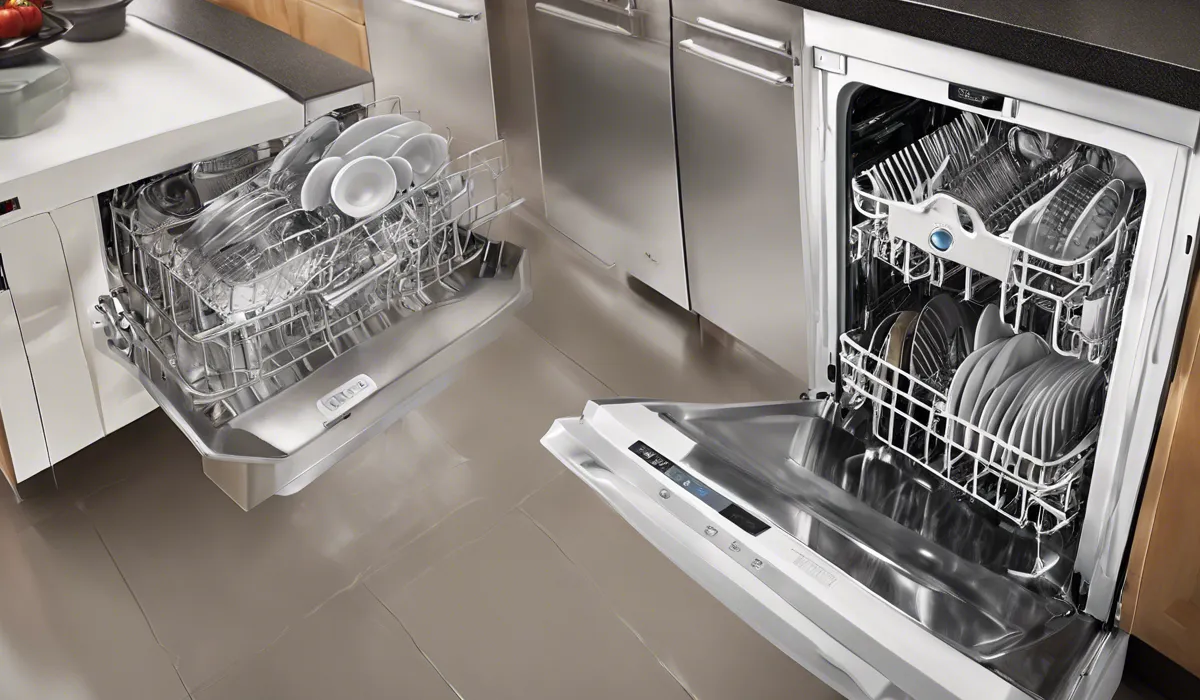How to Kasher a Dishwasher: A Step-by-Step Guide
To kasher a dishwasher, first clean and don’t use it for 24 hours. Then, run it on the highest heat setting with a cup of koshering agent. Ensure all removable parts are treated separately.
Understanding the Basics of Kashering a Dishwasher

Explanation of Kashering
To maintain a kosher kitchen, one must adhere to the Jewish dietary laws, which include the process known as kashering. Kashering is the procedure of purifying kitchen utensils and appliances so they can be used to prepare kosher food.
This purification ensures that no traces of non-kosher food remain on the surfaces that come into contact with food items. It is a critical element of keeping a kitchen compliant with kosher standards.
The Importance of Kashering for Maintaining a Kosher Kitchen
A kosher kitchen is one that follows the strict dietary guidelines set forth in Jewish law.
These guidelines go beyond what foods are permissible; they also dictate how food should be prepared and which dishes and appliances can be used.
By kashering a dishwasher, individuals ensure that their dishes and utensils are free of any non-kosher residue, thus maintaining the sanctity of their kosher kitchen environment.
Identifying the Different Types of Dishwashers
Dishwashers vary in type and functionality. Some have stainless steel interiors, while others have plastic. There are also differences in heating elements, with some located at the bottom of the unit and others within the walls.
Identifying your dishwasher type is crucial because the kashering process may vary depending on these characteristics.
The Role of Materials in Kashering
The material composition of your dishwasher affects the kashering process. Plastic components can absorb flavors and aromas more readily than metal, potentially requiring a more thorough kashering process.
Conversely, stainless steel is less porous and can be kashered more easily. Knowing the materials your dishwasher is made from will guide you in how to effectively kasher it.
Preparing the Dishwasher for Kashering

Cleaning the Dishwasher Thoroughly
The first step in kashering your dishwasher is giving it a thorough clean. Remove all racks and utensil holders and scrub them to ensure no food particles are left.
Look closely at the spinning arms and soap dispensers, as residue can accumulate there as well. A clean dishwasher ensures that the kashering process can proceed effectively.
Waiting Period Before Kashering
Once the dishwasher is clean, it is essential to wait 24 hours before kashering.
This waiting period allows any absorbed flavors in the dishwasher walls and components to dissipate, ensuring a more effective kashering process.
It is a vital step that cannot be skipped.
Checking for and Addressing Problematic Areas
Before kashering, inspect your dishwasher for areas that may harbor food particles. Filters, crevices, and dishwasher traps are common spots where residue can hide.
Clean these areas thoroughly, as any remaining food particles can compromise the effectiveness of kashering.
The Kashering Process

The Boiling Water Method
One common method of kashering a dishwasher involves using boiling water. Begin by filling a cup with water and placing it securely in the dishwasher. Then, run the dishwasher on its highest heat setting.
The goal is to create an environment where steam permeates all surfaces, effectively kashering them. Remember to exercise caution when opening the dishwasher post-cycle, as the steam can be scalding.
Safety Precautions
When using the boiling water method, safety is paramount. Make sure the cup containing water is stable and will not tip over during the cycle.
Additionally, wait a few minutes after the cycle ends before opening the dishwasher door to avoid steam burns.
The Self-Cleaning Cycle Method
Some dishwashers come with a self-cleaning cycle, which can be used for kashering. This cycle typically heats the interior to a high temperature, effectively sterilizing the surfaces.
To use this method, simply run the self-cleaning cycle with koshering agents if your rabbinic authority recommends them.
Differences from the Boiling Water Method
Unlike the boiling water method, the self-cleaning cycle is designed by the manufacturer to clean and sanitize the dishwasher.
The cycle’s duration and temperature settings are preset, making it a more straightforward kashering option.
However, consult your rabbi or a kosher authority to ensure this method is acceptable for your particular dishwasher and community standards.
Post-Kashering Steps
After kashering your dishwasher, it is crucial to verify that the process has been successful.
Check the interior for any signs of food or residue. If the dishwasher is clean and free of any non-kosher traces, it can now be used for kosher food preparation.
Maintaining Kosher Status after Kashering
To maintain your dishwasher’s kosher status, only wash kosher dishes and utensils in it.
If a mistake occurs, such as washing a non-kosher item, consult your rabbinic authority for guidance on re-kashering if necessary. Keeping diligent about what goes into your dishwasher will help preserve its kosher integrity.
FAQs About Kashering a Dishwasher
How do you prepare a dishwasher for kashering?
To prepare a dishwasher for kashering, clean it thoroughly and then refrain from using it for at least 24 hours.
What is the next step after cleaning and waiting 24 hours to kasher a dishwasher?
After cleaning and waiting 24 hours, run the dishwasher on the highest heat setting with a cup of a koshering agent inside.
What type of agent should be used during the koshering process of a dishwasher?
Use a koshering agent, such as a kosher dishwashing detergent or a cleaning agent approved for Passover use.
Do all parts of the dishwasher need to be treated during the koshering process?
Yes, ensure that all removable parts are also treated separately with the koshering agent and the highest heat setting.
How often should a dishwasher be kashered?
A dishwasher should be kashered whenever you want to transition it from non-kosher to kosher use, or before Passover if it has been used with chametz.
Final Thoughts
Kashering a dishwasher requires a thorough cleaning followed by a 24-hour idle period. The next step involves running the machine at its highest heat with a koshering agent.
It’s vital to also separately treat all detachable components to ensure the entire dishwasher meets kosher standards.





